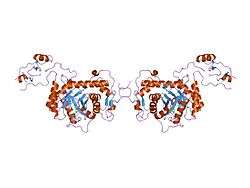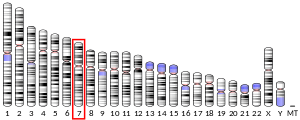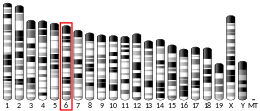IMPDH1
Inosine-5'-monophosphate dehydrogenase 1, also known as IMP dehydrogenase 1, is an enzyme that in humans is encoded by the IMPDH1 gene.[5][6]
Function
IMP dehydrogenase 1 acts as a homotetramer to regulate cell growth. IMPDH1 is an enzyme that catalyzes the synthesis of xanthine monophosphate (XMP) from inosine-5'-monophosphate (IMP). This is the rate-limiting step in the de novo synthesis of guanine nucleotides.[5]
Clinical significance
Defects in the IMPDH1 gene are a cause of retinitis pigmentosa type 10 (RP10).[5][7][8]
gollark: It might make a receiving computer print weird things, at worst.
gollark: That won't do anything.
gollark: Which is entirely possible.
gollark: Unless people deploy really awful code widely.
gollark: Anyway, <@698555539113902111>, your "jammer"/"spammer" would do nothing but mildly reduce TPS.
See also
- IMP dehydrogenase
References
- GRCh38: Ensembl release 89: ENSG00000106348 - Ensembl, May 2017
- GRCm38: Ensembl release 89: ENSMUSG00000003500 - Ensembl, May 2017
- "Human PubMed Reference:". National Center for Biotechnology Information, U.S. National Library of Medicine.
- "Mouse PubMed Reference:". National Center for Biotechnology Information, U.S. National Library of Medicine.
- "Entrez Gene: IMP (inosine monophosphate) dehydrogenase 1".
- Natsumeda Y, Ohno S, Kawasaki H, Konno Y, Weber G, Suzuki K (March 1990). "Two distinct cDNAs for human IMP dehydrogenase". J. Biol. Chem. 265 (9): 5292–5. PMID 1969416.
- Kennan A, Aherne A, Palfi A, Humphries M, McKee A, Stitt A, Simpson DA, Demtroder K, Orntoft T, Ayuso C, Kenna PF, Farrar GJ, Humphries P (March 2002). "Identification of an IMPDH1 mutation in autosomal dominant retinitis pigmentosa (RP10) revealed following comparative microarray analysis of transcripts derived from retinas of wild-type and Rho(-/-) mice". Hum. Mol. Genet. 11 (5): 547–57. doi:10.1093/hmg/11.5.547. PMID 11875049.
- Bowne SJ, Sullivan LS, Blanton SH, Cepko CL, Blackshaw S, Birch DG, Hughbanks-Wheaton D, Heckenlively JR, Daiger SP (March 2002). "Mutations in the inosine monophosphate dehydrogenase 1 gene (IMPDH1) cause the RP10 form of autosomal dominant retinitis pigmentosa". Hum. Mol. Genet. 11 (5): 559–68. doi:10.1093/hmg/11.5.559. PMC 2585828. PMID 11875050.
Further reading
- Mortimer SE, Xu D, McGrew D, et al. (2008). "IMP dehydrogenase type 1 associates with polyribosomes translating rhodopsin mRNA". J. Biol. Chem. 283 (52): 36354–60. doi:10.1074/jbc.M806143200. PMC 2605994. PMID 18974094.
- Ohmann EL, Burckart GJ, Brooks MM, et al. (2010). "Genetic polymorphisms influence mycophenolate mofetil-related adverse events in pediatric heart transplant patients". The Journal of Heart and Lung Transplantation. 29 (5): 509–516. doi:10.1016/j.healun.2009.11.602. PMID 20061166.
- Grover S, Fishman GA, Stone EM (2004). "A novel IMPDH1 mutation (Arg231Pro) in a family with a severe form of autosomal dominant retinitis pigmentosa". Ophthalmology. 111 (10): 1910–6. doi:10.1016/j.ophtha.2004.03.039. PMID 15465556.
- Bowne SJ, Liu Q, Sullivan LS, et al. (2006). "Why do mutations in the ubiquitously expressed housekeeping gene IMPDH1 cause retina-specific photoreceptor degeneration?". Invest. Ophthalmol. Vis. Sci. 47 (9): 3754–65. doi:10.1167/iovs.06-0207. PMC 2581456. PMID 16936083.
- Kimura K, Wakamatsu A, Suzuki Y, et al. (2006). "Diversification of transcriptional modulation: large-scale identification and characterization of putative alternative promoters of human genes". Genome Res. 16 (1): 55–65. doi:10.1101/gr.4039406. PMC 1356129. PMID 16344560.
- Schatz P, Ponjavic V, Andréasson S, et al. (2005). "Clinical phenotype in a Swedish family with a mutation in the IMPDH1 gene". Ophthalmic Genet. 26 (3): 119–24. doi:10.1080/13816810500229090. PMID 16272056.
- Wada Y, Tada A, Itabashi T, et al. (2005). "Screening for mutations in the IMPDH1 gene in Japanese patients with autosomal dominant retinitis pigmentosa". Am. J. Ophthalmol. 140 (1): 163–5. doi:10.1016/j.ajo.2005.01.017. PMID 16038673.
- Wang J, Yang JW, Zeevi A, et al. (2008). "IMPDH1 gene polymorphisms and association with acute rejection in renal transplant patients". Clin. Pharmacol. Ther. 83 (5): 711–7. doi:10.1038/sj.clpt.6100347. PMID 17851563.
- Gandra M, Anandula V, Authiappan V, et al. (2008). "Retinitis pigmentosa: mutation analysis of RHO, PRPF31, RP1, and IMPDH1 genes in patients from India". Mol. Vis. 14: 1105–13. PMC 2426732. PMID 18552984.
- Bowne SJ, Sullivan LS, Mortimer SE, et al. (2006). "Spectrum and frequency of mutations in IMPDH1 associated with autosomal dominant retinitis pigmentosa and leber congenital amaurosis". Invest. Ophthalmol. Vis. Sci. 47 (1): 34–42. doi:10.1167/iovs.05-0868. PMC 2581444. PMID 16384941.
- Xu D, Cobb G, Spellicy CJ, et al. (2008). "Retinal isoforms of inosine 5'-monophosphate dehydrogenase type 1 are poor nucleic acid binding proteins". Arch. Biochem. Biophys. 472 (2): 100–4. doi:10.1016/j.abb.2008.02.012. PMC 2366119. PMID 18295591.
- Gerhard DS, Wagner L, Feingold EA, et al. (2004). "The status, quality, and expansion of the NIH full-length cDNA project: the Mammalian Gene Collection (MGC)". Genome Res. 14 (10B): 2121–7. doi:10.1101/gr.2596504. PMC 528928. PMID 15489334.
- Sanquer S, Maison P, Tomkiewicz C, et al. (2008). "Expression of inosine monophosphate dehydrogenase type I and type II after mycophenolate mofetil treatment: a 2-year follow-up in kidney transplantation". Clin. Pharmacol. Ther. 83 (2): 328–35. doi:10.1038/sj.clpt.6100300. PMID 17713475.
- Ota T, Suzuki Y, Nishikawa T, et al. (2004). "Complete sequencing and characterization of 21,243 full-length human cDNAs". Nat. Genet. 36 (1): 40–5. doi:10.1038/ng1285. PMID 14702039.
- Kozma P, Hughbanks-Wheaton DK, Locke KG, et al. (2005). "Phenotypic characterization of a large family with RP10 autosomal-dominant retinitis pigmentosa: an Asp226Asn mutation in the IMPDH1 gene". Am. J. Ophthalmol. 140 (5): 858–867. doi:10.1016/j.ajo.2005.05.027. PMC 2771559. PMID 16214101.
- Wada Y, Sandberg MA, McGee TL, et al. (2005). "Screen of the IMPDH1 gene among patients with dominant retinitis pigmentosa and clinical features associated with the most common mutation, Asp226Asn". Invest. Ophthalmol. Vis. Sci. 46 (5): 1735–41. doi:10.1167/iovs.04-1197. PMID 15851576.
- Jin P, Fu GK, Wilson AD, et al. (2004). "PCR isolation and cloning of novel splice variant mRNAs from known drug target genes". Genomics. 83 (4): 566–71. doi:10.1016/j.ygeno.2003.09.023. PMID 15028279.
- Roberts RL, Gearry RB, Barclay ML, Kennedy MA (2007). "IMPDH1 promoter mutations in a patient exhibiting azathioprine resistance". Pharmacogenomics J. 7 (5): 312–7. doi:10.1038/sj.tpj.6500421. PMID 17001353.
- Kudo M, Saito Y, Sasaki T, et al. (2009). "Genetic variations in the HGPRT, ITPA, IMPDH1, IMPDH2, and GMPS genes in Japanese individuals". Drug Metab. Pharmacokinet. 24 (6): 557–64. doi:10.2133/dmpk.24.557. PMID 20045992.
External links
- GeneReviews/NCBI/NIH/UW entry on Retinitis Pigmentosa Overview
- Overview of all the structural information available in the PDB for UniProt: P20839 (Inosine-5'-monophosphate dehydrogenase 1) at the PDBe-KB.
This article incorporates text from the United States National Library of Medicine, which is in the public domain.
This article is issued from Wikipedia. The text is licensed under Creative Commons - Attribution - Sharealike. Additional terms may apply for the media files.




